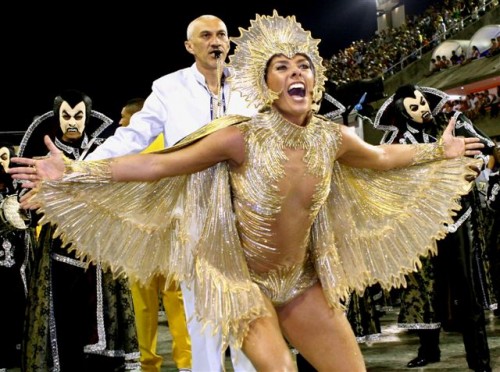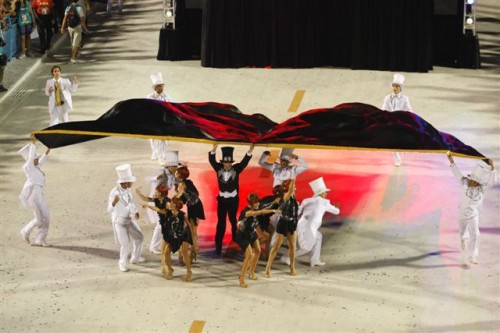Before I was allowed to emplane for Rio I promised to file a report for the Committee of Concerned Elderly Gentlemen on the moral hazards of the Rio Carnival. Here it is.
Considerable efforts are being made to raise the tone of the event and make it acceptable to the most progressive Cultural Studies department. For instance, the Escola de Samba Imperatriz Leopoldinense chose as its theme the religious multiculturalism of Brazil. Here’s the school’s float on Judaism:
Somehow I think that’s not entirely accurate. Surely it was a golden calf not a giant cow? And I must have missed the text “I the Lord thy God am a laid-back-God, let a hundred flowers bloom and all that, hang cool and go with the flow.”
The dancing inside the mosque here is also, I fear, unsound.
They should surely be whirling dervishes, not samba stompers. I missed Christianity during a pizza break, and I don’t know enough about Buddhism and Hinduism to tell you what they got wrong.
Imperatriz didn’t have a chance of winning. They had the sense to realize that their chosen theme made it impossible to adorn the floats with the expected number of half-clad beauties. (A float for Baal-worship would have opened up interesting possibilities.) But overall their real problems were a dull samba tune and little wit in the design. To become champions, the schools don’t compete on pretty girls: the supply in Rio of attractive, extrovert and very fit young women willing to dance 80 minutes on a float in showgirl gear for zero pay is perfectly elastic at the margin and exceeds the number of destaque slots available. Nor are the schools allowed to compete on the degree of nudity; the authorities are determined to keep this a family attraction. The total number of paraders is limited - to 4,000 per school! as is the number of floats.
So the real competition is about design and invention, visual and musical. Sometimes they just try too hard: one ala of Viradouro’s on foot represented “the decline of the Maya from over-exploitation of the forest”. This level of narrative abstraction cannot work outside a theatre. But at it best, the results are extraordinary. the commissão de frente - leading dance group - of the eventual champions Unidos da Tijuca (Hooray! My bairro!) on the theme of “Secrets”, had a top-hatted magician leading the dancers, and covering them with a huge cloth - whisking it away to reveal the women in different coloured dresses. Simple but brilliantly effective.
I’m unsure quite how the Hanging Gardens of Babylon fitted into Tijuca’s theme, but the float had real water cascading down real plants.
The criticism you hear that the Rio carnival has become too commercialised is unfounded. There’s little sponsorship in evidence. The steep ticket prices are recycled to the samba schools, Some of these, notably Beija-Flor, also benefit from the patronage of rich men, and it shows, but the carnival is still far from the crazed billionaires’ potlatch of the America’s Cup. What the carnival has become is stylised by competition. The format of the parade is heavily regulated and far too uniform for my taste: every school has its couple of flag-bearers, an “old guard” of veterans, a group of middle-aged whirling dancers called bahianas, a rainha da bateria, and so on, with almost as many side-competitions as the Oscars. The divide between spectators and participants is clear. You are either one or the other. (I’m talking here about the main carnival parade in the delightfully named Sambodrome, not the informal bloco parties and street parades by bandas.) The atmosphere is that of a very amiable big sporting ocasion; a cricket rather than a football match.
Still, even in this rigid and channelled format, the Rio carnival must be the greatest show of popular theatre on earth. Each of the twelve samba schools in the first division can parade up to 4,000 on the night, and most do. There is also a second division, with somewhat smaller parades, and annual promotions and relegations. The schools start work in May on the next year’s parade. They have their own workshops, float-builders and dressmakers for the critical costumes, though most of the costume-making is farmed out, and the typical parader on foot pays for his or her own outfit. Somewhere between 50,000 and 100,000 cariocas therefore put in work at some time during the year, and a good number full-time, to make the show what it is.
The CCEG can only be partially reassured, however.

(Unidos da Tijuca’s celebrity rainha de bateria, Adriane Galisteu - actually in last year’s outfit, I just like it better than this year’s.)
As they say, more in-depth fieldwork is clearly called for. My funding application to the CCEG is in the mail.

i've read some scholarly commentaries that say "calf" really means more like "young bull." not that i've ever seen a synagogue that features one.
Actually in Portuguese it would not be bairrio, but bairro.
The pedant in me must also point out that it's Unidos da Tijuca, da being a contraction of "de" and the definite article "a."
Thanks Randy, I have fixed the typos so now everyone will wonder what your point was. My view is that bloggers should correct typos (in contrast to errors of fact or reference) without marking them. My Portuguese is I admit exceedingly basic.